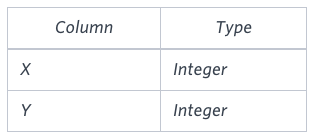-
Notifications
You must be signed in to change notification settings - Fork 0
/
15_symmetric_pairs.sql
81 lines (70 loc) · 1.5 KB
/
15_symmetric_pairs.sql
1
2
3
4
5
6
7
8
9
10
11
12
13
14
15
16
17
18
19
20
21
22
23
24
25
26
27
28
29
30
31
32
33
34
35
36
37
38
39
40
41
42
43
44
45
46
47
48
49
50
51
52
53
54
55
56
57
58
59
60
61
62
63
64
65
66
67
68
69
70
71
72
73
74
75
76
77
78
79
/*
You are given a table, *Functions*, containing two columns: *X* and *Y*.

Two pairs (X1, Y1) and (X2, Y2) are said to be symmetric pairs if X1 = Y2 and X2 = Y1.
Write a query to output all such symmetric pairs in ascending order by the value of X.
- Sample Input
+------+------+
| X | Y |
+------+------+
| 20 | 20 |
| 20 | 20 |
| 20 | 21 |
| 23 | 22 |
| 22 | 23 |
| 21 | 20 |
+------+------+
- Sample Output
20 20
20 21
22 23
*/
-- first version
SELECT
DISTINCT
f1.x,
f1.y
FROM (
SELECT
x,
y,
ROW_NUMBER() OVER(PARTITION BY x, y ORDER BY x) as cnt
FROM
functions) AS f1
JOIN
functions AS f2
ON
f1.X = f2.Y AND
f1.Y = f2.X AND
(f1.X != f1.Y OR cnt > 1) AND
f1.X <= f1.Y
ORDER BY
f1.X
;
-- another
WITH funcs AS(
SELECT
f1.X,
f1.Y
FROM
functions AS f1,
functions AS f2
WHERE
(f1.X = f2.Y AND f2.X = f1.Y )
)
SELECT *
FROM
(SELECT
CASE WHEN x <= y THEN x
WHEN x > y THEN y
END AS x,
CASE WHEN x <= y THEN y
WHEN x > y THEN x
END AS y
FROM funcs ) as tmp1
GROUP BY
x,y
HAVING
COUNT(*) >= 2
ORDER BY
x;